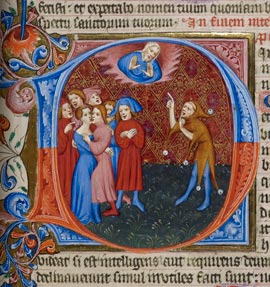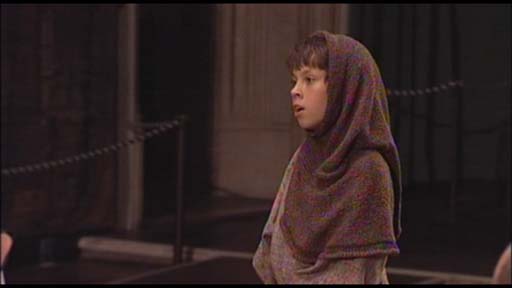Instructions for 'Porters at the Gate'
 Psalm 52: initial 'D' shows God in cloud, below group of people, with a man and a woman embracing, and a fool.
Psalm 52: initial 'D' shows God in cloud, below group of people, with a man and a woman embracing, and a fool.Image taken from Great Bible (St. Jerome version).
Originally published/produced in England (London?), 1405-1415.
The following is a series of instructions contained in the 1540 additions to The Eltham Ordinances of 1526 for those employed as ‘Porters at the Gate’ at the court.
The Eltham Ordinances were passed in 1526 and presented in public as a serious attempt to reform the court, although it is now recognised that they also had the effect of increasing the power of Thomas Wolsey. They set out in detail how the court should be organised and run. In particular, they attempt to prevent members of the court and its servants from profiting from their positions. The Ordinances even attempt to control what happens to the remnant of spent candles as a way of ensuring control of expenditure on the court. They also make a point of seeking to exclude specific groups from the court, including cripples, beggars and boys.
The Serjeant Porters with the residue of their Officers there, shall give their dayly attendance, and be of good rule and governance; and that they doe not onely exclude Servants, Vagabonds, and Rascalls out of their Office, but alsoe that they doe not suffer any Vagabonds, Rascalls, or Boyes, to enter in at the Gate at any time ; and that one of them shall three or four times in the day make due search throught the House, in case that negligently at any time, any Boyes or Rascalls have escaped by them, and entred the Gates, that thereby they may find them out, and put them out againe, upon paines as is before expressed.
References:
The Society of Antiquaries (ed.), A Collection of Ordinances and Regulations for the Government of the Royal Household, Made in Divers Reigns. From King Edward III to King William and Queen Mary. Also Receipts in Ancient Cookery (London, 1790), p. 239.










